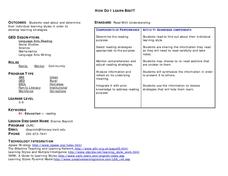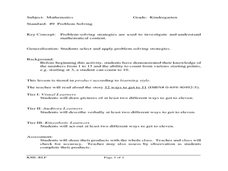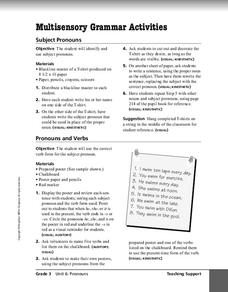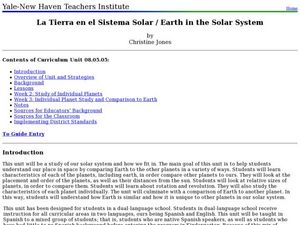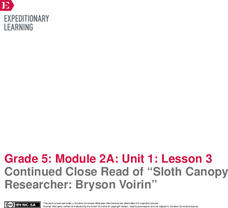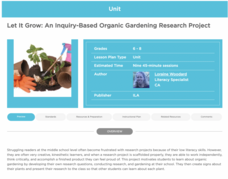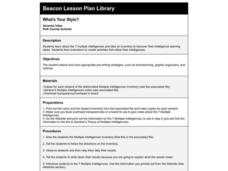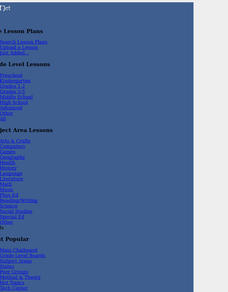Curated OER
How Do I Learn Best?
Students discover their learning styles. In this language arts lesson, students read about the various learning styles. Students determine their learning style and discuss how they can use this knowledge.
Curated OER
Learning Styles in Math
Students discover which learning style works best for them in a math setting. In this math comprehension lesson, students create different combinations of numbers that equal the sum of 11. Students determine if they are better visual,...
Houghton Mifflin Harcourt
Multisensory Grammar Activities
Meet your scholar's individual needs with four activities designed to address auditory, visual, and kinesthetic learning styles to reinforce the concept of subject and object pronouns.
Houghton Mifflin Harcourt
Multisensory Grammar Activities
Activate various learning styles while covering modifiers and double negatives. These activity ideas provides several sentences for examining each topic. After completing the activities, learners will know how to clarify meaning with...
Curated OER
Four Learning Styles
Students play a game where they insert the states of the United States onto a map, and discuss the four learning styles as they play. In this learning styles lesson plan, students discuss how each learning style would play and think...
Curated OER
Hula Hoop ABC Relays
Adding hula hoops to any activity can present a fun challenge. This worksheet explains how to conduct an activity that combines the recognition of capital/lowercase letters and a hula hoop relay. Outside on the playground, each student...
Curated OER
Earth in the Solar System
A three-week unit designed to be completed in an elementary level, dual-language immersion classroom, this resource includes several lessons intended to introduce young learners to the solar system, the Earth and how the Earth compares...
Florida Center for Reading Research
Syllable Hopscotch
Let your little learners move while they practice breaking words into syllables or chunks. Place a hopscotch "board" on the floor (this can be done with tape). Your class takes turns choosing picture cards, and then they say the name of...
Nancy Fetzer's Literacy Connections
Expository Paragraph
Upper elementary and middle school writers learn how to craft an expository paragraph by following the six steps detailed in a 48-page instructional guide. Learners learn how to write six different types of informational paragraphs:...
Curated OER
Mouse Painting (Color Mixing)
After reading the story Mouse Paint by Ellen Stoll Walsh, little ones make a mouse painting of their own. They discuss mixing colors, painting, and the story, then they "dance" with their fingers through puddles of paint.
Curated OER
Rainbow Spelling: A Kinesthetic Approach to Encoding
Have your young learners interact with phonemes through this tactile plan! Each learner will have a colored mat where they connect different phonemes to create words. The best part is that they can self-correct easily as they spell!
EngageNY
Continued Close Read of “Sloth Canopy Researcher: Bryson Voirin”
Let's explore the rainforest by studying its inhabitants. Pupils continue reading an interview with a sloth scientist and answer text-dependent questions. Next, they engage in a class discussion to share the new facts they learned about...
ReadWriteThink
Let It Grow: An Inquiry-Based Organic Gardening Research Project
How does your garden grow? An inquiry-based, organic gardening unit asks young scientists to research a vegetable or flower, create an environment for it, and then plant and tend to the seedling. Gardeners develop their own research...
Curated OER
What's Your Style?
Students examine and discuss the seven multiple intelligences. They take an inventory to identify their own learning styles and design activities that utilize their intelligences.
John Talavera
Autism iHelp – Opposites
In/out, up/down, big/small; understanding opposites is a fundamental vocabulary-building skill. This app uses real-life photographs, to introduce the learner to the concept of opposites. Learning opposites is necessary for understanding...
Florida Center for Reading Research
Phonological Awareness: Phoneme Segmenting, Phoneme Hopscotch
Your class will love playing phoneme hopscotch! Scholars choose a card, say the name of the object on the card, break the word into phonemes, count the phonemes, then hop that many spaces on the hopscotch mat. Super fun!
Teachers.net
Chicka-Chicka-Boom-Boom/ Chicka Challenge (Elementary, Literature)
Is your Kindergarten class about to read the book, Chicka-Chicka-Boom-Boom? If they are, and you want a few wonderful activity ideas to reinforce phonemic awareness and letter identification skills, look no further. Here you'll find over...
Meadows Center for Preventing Educational Risk, University of Texas at Austin
Lesson 8 - Open Syllables
Just like scholars plug something in to close a circuit, they must plug a consonant onto a word to make closed syllables. Help learners distinguish between open and closed syllables with a series of activities that emphasize open...
Teaching Tolerance
Constructively Engaging in Digital Communities
Say no to hate speech! Pupils discover the importance of practicing empathy and inclusivity in digital communities and discuss strategies for responding to online hate speech. Then, small groups develop and present class guidelines for...
Curated OER
Count by 5's Teaching Idea
Creating while learning is great for visual, spacial, and kinesthetic learners. First graders can use the provided quilt squares to construct their very own count by 5 quilt. Each quilt square shows a picture of a hand with a 5s number...
EngageNY
Vocabulary: Finding the Meaning of Words in Context in The Boy Who Loved Words
Here is a lesson plan that invites learners to engage in a kinesthetic activity that allows them to physically move and manipulate words in order to think about ways to understand vocabulary in context. After that activity is complete,...
Curated OER
See It, Say It, Move It, Do It!
Learn two new letters a week with this activity! After learning the two target letters, the class will make an alphabet video "performing" each letter. The letter's name, sound, and a motion associated with it will be included in the...
EngageNY
Understanding Themes in Esperanza Rising
Determining a theme or central idea is greatly emphasized in the Common Core standards. Target that skill though big metaphors and central symbols in Pam Muñoz Ryan's Esperanza Rising. Help your class reach the standard through...
Meadows Center for Preventing Educational Risk, University of Texas at Austin
Lesson 2 - Consonant-Vowel-Consonant Words
Closed syllable words contain short vowel sounds. A phonics lessons introduces readers to consonant-vowel-consonant words. Guided instruction introduces the words with a series of dictation activities, and then learners practice reading...
